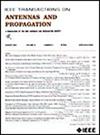An X-/Ka-Band Shared-Aperture Linear-to-Circular Polarization Converter
IF 4.6
1区 计算机科学
Q1 ENGINEERING, ELECTRICAL & ELECTRONIC
引用次数: 0
Abstract
This article presents a novel design method for a dual-band shared-aperture linear-to-circular polarization (LP-to-CP) converter. High-impedance structures and a bandpass frequency selective surface (FSS) are employed to achieve low interferences between the X- and Ka-band elements. In this article, a high-impedance structure is incorporated into the X-band element to eliminate high-order modes and prevent phase differences between TE and TM modes. Additionally, a bandpass FSS is employed to mitigate the influence of the high-frequency (HF) element on the low-frequency (LF) element. Based on this method, an X-/Ka-band converter with a two-layer structure is proposed. The X-band element consists of two groups of split rings and cross strips, which are printed on the topmost and bottom layers of the substrate. The Ka-band element comprises a Jerusalem cross printed in the middle layer and a metal strip printed on the same layer as the X-band element. The equivalent circuit model (ECM) is used to analyze the response of the converter. An X-/Ka-band LP-to-CP converter prototype is fabricated and integrated with array antennas to validate the design concept. The experimental results indicate that the array antennas integrated with the proposed converter can achieve an overlapped impedance and axial ratio bandwidths (ARBWs) of 11.1% (8.18–9.14 GHz) and 13.6% (25.95–29.73 GHz), with maximum gains of 12.8 and 16.4 dBic in two frequency bands, respectively.一种X / ka波段共孔径线圆偏振变换器
本文提出了一种新的双频共孔径线圆偏振转换器的设计方法。采用高阻抗结构和带通频率选择表面(FSS)来实现X和ka波段元件之间的低干扰。在本文中,在x波段元件中加入了高阻抗结构,以消除高阶模式,并防止TE和TM模式之间的相位差。此外,采用带通FSS来减轻高频(HF)元件对低频(LF)元件的影响。在此基础上,提出了一种双层结构的X / ka波段变换器。x波段元件由两组分裂环和交叉带组成,分别印刷在衬底的最顶层和底层。所述ka波段元件包括印刷在中间层的耶路撒冷十字和印刷在与所述x波段元件相同层上的金属条。采用等效电路模型(ECM)对变换器的响应进行了分析。制作了X / ka波段LP-to-CP转换器原型,并与阵列天线集成以验证设计概念。实验结果表明,集成该变换器的阵列天线可实现11.1% (8.18 ~ 9.14 GHz)和13.6% (25.95 ~ 29.73 GHz)的重叠阻抗和轴比带宽(ARBWs),两个频段的最大增益分别为12.8和16.4 dBic。
本文章由计算机程序翻译,如有差异,请以英文原文为准。
求助全文
约1分钟内获得全文
求助全文
来源期刊
CiteScore
10.40
自引率
28.10%
发文量
968
审稿时长
4.7 months
期刊介绍:
IEEE Transactions on Antennas and Propagation includes theoretical and experimental advances in antennas, including design and development, and in the propagation of electromagnetic waves, including scattering, diffraction, and interaction with continuous media; and applications pertaining to antennas and propagation, such as remote sensing, applied optics, and millimeter and submillimeter wave techniques

 求助内容:
求助内容: 应助结果提醒方式:
应助结果提醒方式:


